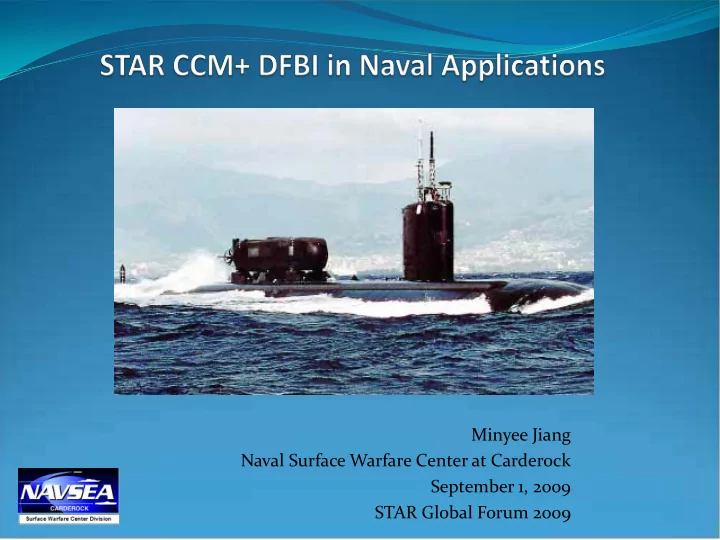

Minyee Jiang Naval Surface Warfare Center at Carderock September 1, 2009 STAR Global Forum 2009
STAR-CCM+ in NSWCCD CFD Applications Hull CFD Resistance Validations prediction Internal flow Wave slap plus ship-wave prediction interaction
Background Traditional Submarine Mission: Prior to the end of the Cold War conflict between two super powers, anti-submarine warfare and the delivery of massive nuclear fire power were the major roles for U.S. submarines. The “Silent Service” was the major concern for submarine operations. Opportunities for submarine to encounter waves were very rare . New Missions: . Now dealing with multiple small conflicts through out the world, U.S. submarines are more multi-mission oriented, including assisting Special Operating Forces. Submarine operation is no longer completely silent in deep sea. More often submarines encounter waves. New configurations: Dry Deck Shelter (DDS) and Advanced Seal Delivery System (ASDS) mounted on host submarines.
ASDS Wave Slap Simulation Task Title : Initial Investigation of Wave Impact Loading Trends on the ASDS Objective : Simulate forces on ASDS under various wave height, wavelength, and wave heading to identify trends where ASDS systems may experience significant forces. Results could lead to identification of potential problem areas with high loading Approach : Computational Fluid Dynamics approach for pressure loading by simulation of the interaction of the wave field with the ASDS mated to the host ship
Numerical Tool and Method STAR-CCM+ A Reynolds Averaged Navier-Stokes (RANS) code, developed by CD- Adapco, was designed to solve wave interaction problems and is applicable to surface ships and submarines. VOF Vo lume of fluid (VOF) is one of the approaches for accurately computing free surface flows and breaking waves. Grid cells near the free surface are filled partially with air and water and computed appropriately based on VOF.
Volume of Fluid Free Surface Capturing air water
ASDS Wave Slap Simulation Geometries for the Numerical Model ASDS on a submarine Still water line The propellers of ASDS and submarine are not included in the numerical model
Close up View on ASDS ASDS Hull Control surfaces ASDS was raised few inches for grid generation purpose Pylons and Matting trunk
Computational Domain and Grid Local Grid Cell Zones Refinement Inlet Cells near ASDS Interest Damping Region of interest
Grid Topology I ( Single region with stretched wave damping zone) velocity inlet Pressure outlet Velocity Inlet Velocity inlet
Grid Topology II ( Embedded mesh with stretched wave damping zone) velocity inlet Pressure outlet Velocity Inlet Interface
Grid Topology III ( Single region without stretched wave damping zone) Pressure outlet Velocity Inlet Velocity Inlet Velocity inlet
Grid Topology I (Single region) d =20L Because the outlet boundary is located far downstream, free surface is outside the fine grid region even for small pitch angle
Grid Topology I (Single region) Free surface enters coarse grid region
Grid Topology II (Embedded Grid) Interface for grid rotation Free surface stays in fine grid region
Grid Information 2 - 6 M cells Evenly distributed cells in the inlet region Stretched grid size in the damping zone
Wave Conditions Averaged Wave Height (H=20 feet) Averaged Wave Length ( λ =262 feet) Wave Heading: (Beam Sea) Positions : broach Forward speeds : 0 knot
Submarine and ASDS at Broach Condition Free Surface Wave direction
Sample of the Surface Pressure Pressure Animation Areas with High impact load
Wave Slap Peak Pressure on ASDS Large peak pressure with small duration More sustain load
Wave Slap Peak Pressure on ASDS Elements More vulnerable element
Conclusions STAR-CCM+ has been successfully applied to several Navy vessels for resistance prediction and wave impact analysis. More wave slap/slam validations and simulations are in progress. Simulation of LCS-2 requires modeling of interaction of ship with wave as well as internal flow We are gradually increasing our usage at DoD-HPC. We are expecting to have more allocation available at several computing centers next year. Fluid-Structure Interaction (FSI): We are currently waiting for the release of STAR-CCM+ coupled with ABAQUS for accurately prediction of wave impact load.
Recommend
More recommend